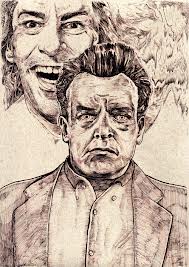I genuinely learned a lot from this assignment—I’ve seen Kaufman’s Synecdoche, New York many times over (as one has to in order to truly grasp its meaning), but I haven’t once thought to look up what the word “synecdoche” meant. After that, I’ve been seeing it everywhere, especially in my literature courses. Faulkner uses tons of literary synecdoche in his short story “Barn Burning,” for example. Lighting has always been a subconscious thing for me until this point—I didn’t realize how much of an impact a films lighting can have on the aura the film gives off. In Requiem for a Dream, for instance, I’ve realized that the lighting has a whole lot to do with the film’s feel. And while I’ve known what a metaphor was for a while, it actually took me a bit of thinking to get my head wrapped around the depiction of a metaphor in visual format. The notion of “visual metaphor” is now in my visual interpretation toolkit; hopefully I can spot more of them in the films I’ll see in the future.
Monthly Archives: December 2012
Communication: Lighting
This is a youtube video of an anonymous caller who claims to be in possession of a highly sensitive piece of video footage. In order to preserve his identity and anonymity, he is silhouetted:
https://www.youtube.com/watch?v=o160kbVvzOQ
When one speaks of the lighting of an image that person is commenting on how the lightness and shadows work with an object or action to create certain vibes and feelings that would otherwise be absent. For instance, fluorescent lights are typically associated with harshness and the unnatural, so when an image is taken in a fluorescent light it will carry those attributes with it. That’s why dystopian films like Visioneers use fluorescent lights to create a sterile, bland, and flat vibe/feel. A lack of lighting—or shadows—can be used to completely erase one’s identity, at least on camera. In the example video above, some guy wants to preserve his identity by having his talking head silhouetted in darkness. Without lighting, as we can see (or not see), this man would have to either keep his absurd secrete to himself or reveal his identity for his perceived ‘greater good.’
Filed under Uncategorized
Communication: Visual Synecdoche
Charlie Kaufman’s screenplay/Spike Jonze’s film Adaptation uses Synecdoche as the basis for the films plot/theme:

https://www.youtube.com/watch?v=0HtZ2M4e_AM
As mentioned in class, Charlie Kaufman’s Synecdoche, New York is one big visual synecdoche, yet his second major motion picture screenplay, Adaptation, he does the same thing in another manner. Adaptation is a metafictional film about a man’s desperate attempts to adapt a non-fiction memoir about orchids (The Orchid Thief) into a screenplay adaptation. Synecdoche is when some part of something comes to represent the whole of whatever it is a part of. In Adaptation, Kaufman’s impossible endeavor to adapt a meditation on flowers into a feature length screenplay is only part of the movie at first, yet as the film progresses, we see that this endeavor—this small part of the film—comes to represent the whole film, hence the films title. Using synecdoche, the smaller part—Kaufman’s attempt to adapt the impossible—becomes the larger part—the movie Adaptation. This creates an intricate display of an endeavor that morphs into its own solution–the part becomes the whole.
Filed under Uncategorized
Communication: Visual Metaphor
A visual metaphor can be seen in Bob, the antagonist in the Twin Peaks saga:
https://www.youtube.com/watch?v=wj_ozZOBTGg
In surrealist visual artist David Lynch’s cult TV saga, Twin Peaks, the notoriously crazy-eyed “Bob” is an entity from “the Black Lodge”—a spiritual realm that embodies everything evil. According to my interpretation, Bob being sent down from the Black Lodge to wreak havoc on the Palmers is a metaphor for the inexplicable and mysterious origin of evil, providing the audience with a visual representation of such ineffable acts (i.e., Leland Palmer’s incestuous murder of Laura Palmer). To create a metaphor is, essentially, to draw a connection between two things—a parallel of sorts. Usually an object or action that is difficult to describe (sometimes even ineffable, as with justifying incest & murder) is related to another object or action (a crazy spirit man) that is perhaps more familiar or comprehensible to the viewer, thus clarifying and further elucidating the former action or object, giving it more depth. Obviously there is a lot more going on in Twin Peaks and Bob than just metaphor, but for the most part this Bob entity is a visual metaphor for the human potential to rape and kill one’s own daughter.
Filed under Uncategorized
The Beat Generation Collage
My Beatnik Pastiche: http://www.glogster.com/glog/6l3prdahmuu86g604076ja0
A superbly produced documentary on the Beat Generation:
Filed under Uncategorized


